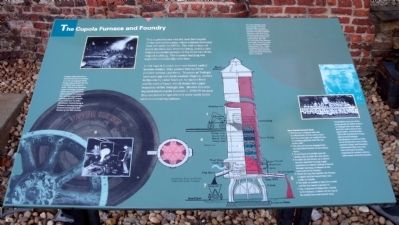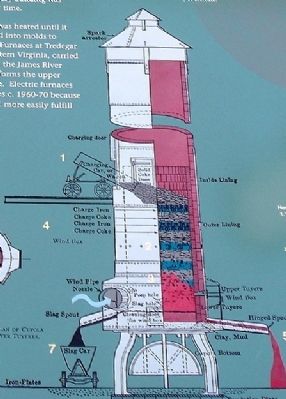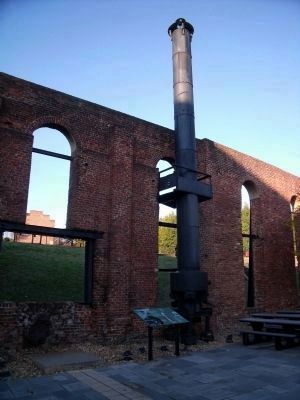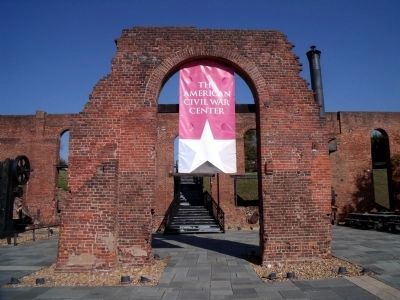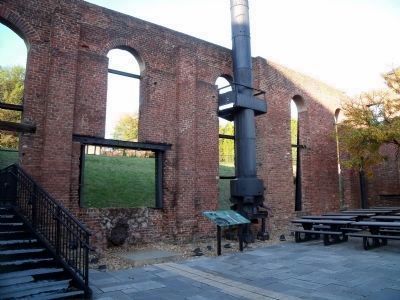Gambles Hill in Richmond, Virginia — The American South (Mid-Atlantic)
The Cupola Furnace and Foundry
In the cupola furnace, iron was heated until it became molten, then poured into molds to produce various cast items. Furnaces at Tredegar once used pig iron from western Virginia, carried to this site by canal boats on the James River and Kanawha Canal, which forms the upper boundary of the Tredegar site. Electric furnaces replaced most cupola furnaces c. 1960-70 because they are easier to operate and more easily fulfill environmental regulations.
(sidebar)
How cupola furnaces work
1. The furnace is charged with coke (a refined form of coal used as fuel) and iron is brought on small rail cars to a loading platform near the top of the stack.
2. The coke and iron are dumped into the brick-lined furnace in alternating layers.
3. As each layer of fuel falls into the melting zone, it melts iron above.
4. To make the fire hotter, air is blown into the wind belt through a pipe connected to a blower, and air is forced through openings or tuyeres in the inner part of the furnace.
5. When the iron has melted, the furnace is tapped, and hot metal flows into a ladle or crucible.
6. The ladle or crucible is taken to a mold and the hot metal is poured in.
7. Slag, composed of impurities created by the furnace, is taken off of the top of the melted iron and carried away.
Topics. This historical marker is listed in these topic lists: Architecture • Industry & Commerce • Labor Unions • Railroads & Streetcars • Waterways & Vessels.
Location. 37° 32.131′ N, 77° 26.727′ W. Marker is in Richmond, Virginia. It is in Gambles Hill. Marker can be reached from Tredegar Street, 0.1 miles west of South 5th Street. This marker is located outside the Civil War Visitor Center at Tredegar Iron Works. Touch for map. Marker is at or near this postal address: 470 Tredegar Street, Richmond VA 23219, United States of America. Touch for directions.
Other nearby markers. At least 8 other markers are within walking distance of this marker. Toledo 1000-ton Press (a few steps from this marker); Enterprise and Iron (a few steps from this marker); Tredegar Iron Works (a few steps from this marker); The Gun Foundry (within shouting distance of this marker); Raceways (within shouting distance of this marker); a different marker also named The Tredegar Iron Works (within shouting distance of this marker); Adapting Power (within shouting distance of this marker); Early Industrial Patterns (within shouting distance of this marker). Touch for a list and map of all markers in Richmond.
More about this marker. On the left are images illustrating the carwheel casting process bearing the caption, “Tredegar made railroad carwheels over much of its history. In the photograph below, workers pour molten iron into a carwheel flask, a type of mold. Patterns for carwheels made at Tredegar, pictured below, had interchangeable plates bearing the initials of the railroads they served, including the ACL (Atlantic Coast Line) and the RF&P (Richmond, Fredericksburg & Potomac), showing how standardized railroad parts had become by the 20th century.”
In the center is a "Sectional plan of cupola through lower tuyeres". The caption above reads, “The small Tredegar cupola and the larger cupola are good examples of cupola furnaces. The larger furnace was recovered from a foundry about two miles from here, and dates from around 1910. It was used by the James W. Carr Foundry, later the O. G. McGee& Son Foundry and finally Capital Foundry, Inc., and was probably last fired around 1964. When traveling around the city, notice the many manhole and water meter covers cast by O. G. McGee.”
On the right is a photograph of iron workers with the caption, “Ironmolders were one of the many groups of skilled workers at Tredegar who were organized into craft unions in the metal trades. Local Number 128 of the Ironmolders Union represented Tredegarís foundrymen, as well as molders in Richmondís stove works, machine shops, and foundries. Unions provided some sickness and injury benefits, important to workers with no other source of health benefits.”
Credits. This page was last revised on February 1, 2023. It was originally submitted on November 6, 2009, by Bernard Fisher of Richmond, Virginia. This page has been viewed 3,948 times since then and 18 times this year. Photos: 1, 2, 3. submitted on November 6, 2009, by Bernard Fisher of Richmond, Virginia. 4. submitted on November 8, 2009, by Bernard Fisher of Richmond, Virginia. 5. submitted on November 6, 2009, by Bernard Fisher of Richmond, Virginia.
